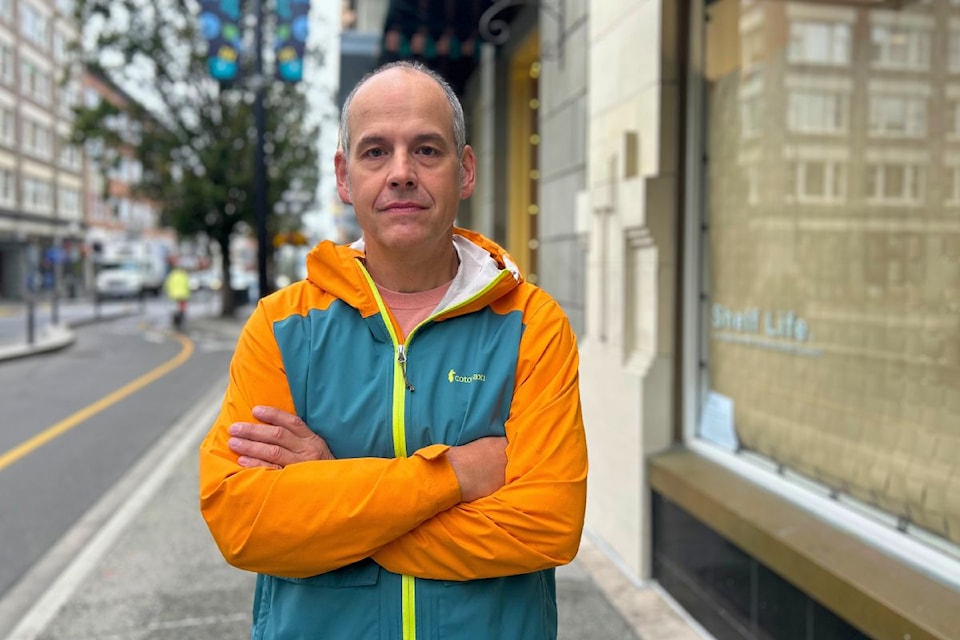Walking along Fort Street just past Douglas, one might happen upon a window with a woven sculpture behind the words Shelf Life.
But what people won't know at first glance is the piece represents an artist's meaningful act of re-connection to his mother's lost culture and a way to honour inter-generational trauma after his uncle was abducted as a toddler decades ago.
Ronnie Montreal's woven Mi'kmaq oversized basket, or wigwam, titled "Ta'pitj'ij" (Little David) is currently on display in the windows of 670 Fort St. The artwork, accompanied by a story accessible via a QR code, can be viewed until Sept. 30. This piece is part of the Victoria Arts Council (VAC) project called "Shelf Life," curated by Kegan McFadden, also executive director of Victoria Arts Council.
The tragic story of how colonization affected his family begins with Montreal's mother, Marion, placed in a residential school as a child. In 1949, seven-year-old Marion was given shocking news: her three-year-old brother, affectionately called Little David, was abducted from the fenced-in and gated yard of their home in Membertou, N.S.
“He was three years old when he was taken away from the front of our house. We never saw him again," she said in the audio accompanying the piece. "I remember the feeling ... This little person was my brother."
Six years later, Montreal's grandmother pulled the kids out of the residential school – likely allowed because she was remarried at that point – and moved the family to Toronto, Ont.
"She does that and in doing so, cuts a lot of her culture off by leaving Nova Scotia behind completely," Montreal said. "Their culture had been lost already [by colonization] and the move cut it off even more."
Marion's Indigenous status was later stripped away when she married a European English man in the '60s – Montreal's father – as was custom of the time. It was later reinstated in the '80s by the Canadian Government.
The abduction, the residential school experience, and the family's subsequent severance from their Indigenous roots has had lasting inter-generational effects. Montreal always knew he was part Indigenous but remembers only small glimpses of cultural influences from his mom's side, such as getting beadwork for gifts.
He said a desire to know more about the Mi'kmaq culture and what was lost to their family was always on his mind.
"Between me and my cousins, a few of us are starting to reconnect with the culture and the language," Montreal said. "Because there's something missing. [My mother's] experiences have left a hole in me, and many questions about identity."
It's been about 25 years since he created art. Montreal, who has a Masters in Fine Arts and had a career as an artist in New York in the 1990s under his belt, found a fire of inspiration lit under him once again.
“After COVID-19, I felt a need for artists to provide healing,” he said.
He turned to YouTube to learn the art of Mi'kmaq basket weaving.
"I was always especially interested in the object side, the material side of art making. I wanted to also learn something about my own culture," he said.
The final Ta’pitj’ij (Little David) piece incorporates influence from his background in construction and carpentry, using thick recycled paper used in construction instead of cedar.
"I think those materials are easily relatable to people. They're not so high saluting like bronze or something, so there's sort of a secular feel to them and that's an important part of First Nations culture; that there is no separation between the secular and the sacred," he said.
Ta’pitj’ij came to him as an idea after speaking with McFadden about the Shelf Life project, focused on "an examination of the finite, of mortality, exhaustion, and the possibility of what’s to come as well as what is left behind".
While it was important for Montreal to reconnect with his roots, another integral part of the piece was giving his mother a narrative voice in the audio.
"Her telling is what's really important because it encompasses so much more than just this child being lost," Montreal said.
"I hope in some way to bring my uncle's spirit peace and help heal my family and my community," he adds in a Victoria Arts Council Instagram post.
The installation is visible any time at 670 Fort St., next to Bento Sushi. Montreal said he has to thank McFadden and other curators who have recently given him the chance to show his work again.

